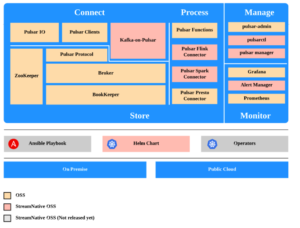

(Jurik Peter/Shutterstock)
StreamNative, which launched a cloud-based version of Apache Pulsar two months ago, today announced that it’s now offering a free entry-level version of Pulsar in the cloud.
Apache Pulsar is the open source publish-and-subscribe (pub-sub) system that competes with Apache Kafka. The software was originally developed at Yahoo to be a geographically distributed, cloud-native messaging system that delivers large volumes of messages in a durable and low latency manner.
Since Yahoo released it as open source in 2016, Pulsar been adopted by a handful of large companies, including Tencent, Verizon Media, Yahoo Japan, Comcast, Appen, Overstock, and Nutanix.
The most recent adopter perhaps is Splunk, the big machine data analytics firm, which announced last week at its .conf20 event that it has adopted Pulsar as the core technology underlying the latest release of its Splunk Data Stream Processor (DSP), beating out Kafka.
Splunk’s move perhaps was not surprising, considering that it acquired Streamlio, one of the biggest proponents of Pulsar, one year ago. In addition to netting Streamlio’s software, it brought several of the founding members of the Pulsar project into the big data company.
That acquisition created space for StreamNative, another startup founded around Pulsar, to emerge. StreamNative was founded by Siji Guo, who was one of the original developers of Pulsar and Apache Bookkeeper. Guo, who is a PMC member at the Apache Software Foundation, was also one of the founders of Streamlio, but left the company in 2018.
According to Guo, who is also the CEO of StreamNative, the new free cloud offering will remove barriers to giving Pulsar a whirl.
“When we launched StreamNative Cloud’s Hosted offering, we wanted to remove barriers to adoption for Pulsar,” Guo said. “While it was a great fit for companies that were further along in their adoption journey, there was high demand from people who were just getting started. Namely, developers who wanted to try Pulsar without having to put down a credit card or get approvals. The free offering makes this possible.”
According to the terms of StreamNative’s free cloud offering, interested parties can get a Pulsar cluster with a 1GB of data up and running free of charge, with just a few clicks. The cluster. which runs on Google Cloud, is limited to 100 topics and a throughput of 1 MBps.
It’s not a large cluster, by any means, but it’s free and it lets people get started with Pulsar quickly, which is the whole point. And if customers are happy, they can upgrade to a larger and more capable Pulsar cluster.

StreamNative is developing its Apache Pulsar stack for stream processing (Image courtesy StreamNative)
StreamNative, which has offices in Beijing and San Francisco, launched its StreamNative Cloud offering in August 2020 to provide users with a simple, fast, reliable, and cost-effective hosted Pulsar experience. While Pulsar itself streamlines infrastructure and operations compared to other technologies in the space, “operating a production-grade often requires time and effort that many teams would rather allocate to addressing core business needs,” the company says.
One of the first company’s running on StreamNative Cloud is the Chinese company Bestpay. Weisheng Xie, the chief data scientist at Bestpay, said this about StreamNative’s offering: “With StreamNative Cloud, we are now able to launch a resilient, secure, and scalable event streaming service within minutes. It’s straightforward and extremely easy to use, which greatly boosts the efficiency of our engineering team,” Xie said.
Computing categories benefit from competition, and while Kafka has enjoyed remarkable success as a core message buys, Pulsar looks ready to give it competition. As one of the only independent providers of Pulsar services, StreamNative is a company worth keeping an eye on.
Related Items:
Splunk Makes a Whirlwind of News at .conf20
On the Radar: Promethium, StreamNative, Inzata
Apache Pulsar Ready for Prime Time
May 8, 2025
- Amplitude Announces New Strategic Collaboration Agreement with AWS
- Domino Survey Shows Enterprises Prioritizing Governance Over GenAI Hype
- DataRobot Launches New Federal AI Application Suite to Unlock Efficiency and Impact
- Qlik Announces Close of Significant Investment Led by ADIA and Thoma Bravo
- OpenSearch 3.0 Enhances Vector Database Performance, Search Infrastructure and Scalability to Meet AI-driven Demand
May 7, 2025
- SAS Viya Expands AI Portfolio with Copilot, Intelligent Decisioning, and Synthetic Data Tools
- Grafana Labs Demonstrates Open Source Leadership at GrafanaCON 2025
- Neo4j Launches Industry’s 1st Graph Analytics Offering for Any Data Platform
- Cockroach Labs Brings Distributed SQL to IBM LinuxONE and Linux on IBM Z
- SAS Unveils AI Agents with Customizable Human-AI Interaction for Transparent Decisioning
- Coralogix Launches Continuous Profiling for Real-Time Application Visibility with Minimal Overhead
May 6, 2025
- Forrester Unveils Top 10 Emerging Technologies for 2025
- NetApp and Intel Partner to Redefine AI for Enterprises
- Algolia Introduces Smart Groups to Bring AI-Powered Curation and Automation to Content Teams and Merchandisers
- Traject Data Boosts Visibility into Google’s AI Overview with New Enhancements
- Qlik Accelerates Move to Cloud with New Analytics Migration Tool
- Nasuni Launches Unify Series to Showcase How Unified Data Drives AI Success
- Dremio Launches New MCP Server, Furthering Its Leadership in Accelerating Agentic Applications
- IBM Unveils Hybrid Tools to Scale Enterprise AI Agents
- Snowflake Drives the Future of Automotive with New AI-Powered Solutions
- PayPal Feeds the DL Beast with Huge Vault of Fraud Data
- Google Cloud Preps for Agentic AI Era with ‘Ironwood’ TPU, New Models and Software
- Google Cloud Fleshes Out its Databases at Next 2025, with an Eye to AI
- The Active Data Architecture Era Is Here, Dresner Says
- Slash Your Cloud Bill with Deloitte’s Three Stages of FinOps
- Thriving in the Second Wave of Big Data Modernization
- Monte Carlo Brings AI Agents Into the Data Observability Fold
- AI Today and Tomorrow Series #4: Frontier Apps and Bizops
- Inside the Chargeback System That Made Harvard’s Storage Sustainable
- Three Ways AI Can Weaken Your Cybersecurity
- More Features…
- Google Cloud Cranks Up the Analytics at Next 2025
- GigaOM Report Highlights Top Performers in Unstructured Data Management for 2025
- SnapLogic Connects the Dots Between Agents, APIs, and Work AI
- Databricks and KPMG Invest in LlamaIndex to Unlock Scalable Enterprise AI
- AI One Emerges from Stealth to “End the Data Lake Era”
- Supabase’s $200M Raise Signals Big Ambitions
- Dataminr Bets Big on Agentic AI for the Future of Real-Time Data Intelligence
- Fivetran Aims to Close Data Movement Loop with Census Acquisition
- Do You Own Your Data? Third-Party Doctrine Says No
- Big Data Career Notes April 2025
- More News In Brief…
- Gartner Predicts 40% of Generative AI Solutions Will Be Multimodal By 2027
- AMD Powers New Google Cloud C4D and H4D VMs with 5th Gen EPYC CPUs
- GitLab Announces the General Availability of GitLab Duo with Amazon Q
- BigDATAwire Unveils 2025 People to Watch
- Dataminr Raises $100M to Accelerate Global Push for Real-Time AI Intelligence
- SAS Unveils AI Agents with Customizable Human-AI Interaction for Transparent Decisioning
- Informatica Adds Native Databricks and Enhanced Governance to IDMC on Google Cloud
- Deloitte Survey Finds AI Use and Tech Investments Top Priorities for Private Companies in 2024
- Databricks Announces Data Intelligence Platform for Communications
- Dremio Named Top Vendor in Dresner 2025 Active Data Architecture Report
- More This Just In…
Sponsored Partner Content
-
Mainframe data: A powerful source for AI insights
-
CData recognized in the 2024 Gartner ® Magic Quadrant™ Report
-
Introducing AIStor, the most powerful version of MinIO to date
-
Designing a Copilot for Data Transformation
-
Get your Data AI Ready – Celebrate One Year of Deep Dish Data Virtual Series!
-
Supercharge Your Data Lake with Spark 3.3



























